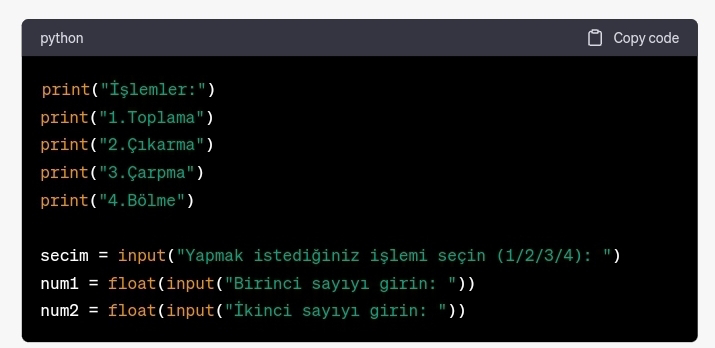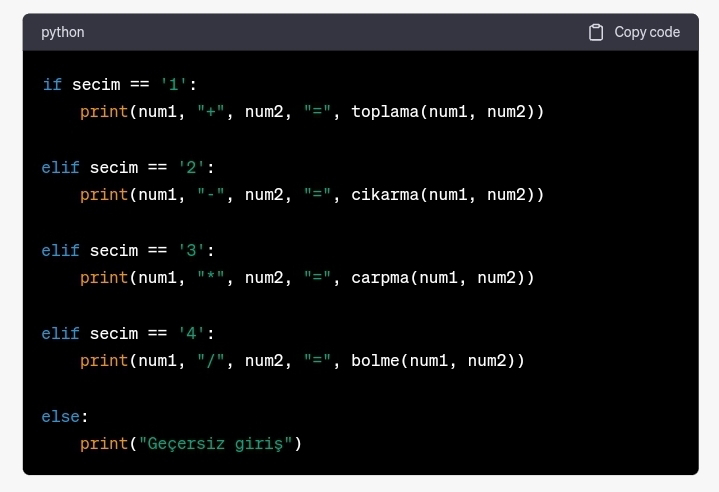Python ile Basit Hesap Makinesi Oluşturma: Adım Adım Rehber / örnek kod
Basit bir hesap makinesi. Python'da, temel aritmetik işlemleri gerçekleştiren basit bir hesap makinesi şu şekilde oluşturulabilir:
```python
def toplama(x, y):
return x + y
def cikarma(x, y):
return x - y
def carpma(x, y):
return x * y
def bolme(x, y):
return x / y
print("İşlemler:")
print("1.Toplama")
print("2.Çıkarma")
print("3.Çarpma")
print("4.Bölme")
secim = input("Yapmak istediğiniz işlemi seçin (1/2/3/4): ")
num1 = float(input("Birinci sayıyı girin: "))
num2 = float(input("İkinci sayıyı girin: "))
if secim == '1':
print(num1, "+", num2, "=", toplama(num1, num2))
elif secim == '2':
print(num1, "-", num2, "=", cikarma(num1, num2))
elif secim == '3':
print(num1, "*", num2, "=", carpma(num1, num2))
elif secim == '4':
print(num1, "/", num2, "=", bolme(num1, num2))
else:
print("Geçersiz giriş")
```
Bu örnek, dört temel aritmetik işlemi gerçekleştiren bir hesap makinesi oluşturur: toplama, çıkarma, çarpma ve bölme. Kullanıcıdan bir işlem seçmeleri ve ardından iki sayı girmeleri istenir. Bu sayılar ve işlem seçimi işlevlere iletilir ve sonuç yazdırılır.
Python, günümüzde en popüler programlama dillerinden biridir ve birçok alanda kullanılmaktadır. İlk olarak 1991 yılında Guido van Rossum tarafından geliştirilen Python, basit, okunabilir ve anlaşılır bir sözdizimine sahiptir. Bu nedenle, özellikle yeni başlayanlar için öğrenmesi kolay bir dildir.
Python, birçok işletim sistemi ve işlemci mimarisi üzerinde çalışabilir. Ayrıca, açık kaynaklı bir dildir ve birçok ücretsiz kaynak ve kütüphane sunar. Bu nedenle, Python, özellikle küçük işletmeler ve girişimciler için maliyet etkili bir seçimdir.
Python'un en büyük avantajlarından biri, zengin bir standart kütüphaneye sahip olmasıdır. Bu kütüphane, birçok işlevi içerir ve Python geliştiricilerinin birçok farklı projede tekrar tekrar kullanabilecekleri hazır kod blokları sunar. Ayrıca, Python, birçok üçüncü taraf kütüphane ve aracı da destekler. Bu kütüphane ve araçlar sayesinde, Python, birçok farklı alanda kullanılabilir hale gelir.
Python, web geliştirme, veri bilimi, yapay zeka, makine öğrenmesi, otomasyon, bilimsel hesaplama, oyun geliştirme ve daha fazlası için kullanılabilir. Python'un geniş kullanım alanları, geliştiricilerin ve işletmelerin birçok farklı projede kullanabileceği bir dil olduğu anlamına gelir.
Ayrıca, Python'un büyük teknoloji şirketleri tarafından da desteklenmesi, dilin popülerliğini artırmıştır. Örneğin, Google, YouTube, Dropbox, Instagram, Spotify ve daha birçok şirket, Python'u kullanan projeler geliştirmişlerdir. Bu şirketlerin desteği, Python'un işverenler tarafından da tercih edilir hale gelmesine yol açmıştır.
Sonuç olarak, Python, basit, okunabilir ve öğrenmesi kolay bir programlama dilidir. Geniş kullanım alanları, zengin bir kütüphane ve araç desteği, ücretsiz olması ve büyük teknoloji şirketleri tarafından desteklenmesi, Python'u birçok geliştirici ve işletme için ideal bir seçim haline getirir.
..
Ayrıntılı açıklama
Python ile Basit Hesap Makinesi Oluşturma: Adım Adım Rehber
Giriş
Python, öğrenmesi kolay ve kullanışlı bir programlama dilidir. Bu rehberde, Python kullanarak basit bir hesap makinesi uygulaması oluşturacağız. Bu uygulama, dört temel aritmetik işlemi gerçekleştirebilecek: toplama, çıkarma, çarpma ve bölme. Başlayalım!
Adım 1: İşlem Fonksiyonlarını Tanımlama
İlk olarak, dört temel aritmetik işlemi gerçekleştiren fonksiyonları tanımlayacağız. Bu fonksiyonlar, iki sayıyı (x ve y) alacak ve sonucu döndürecektir.
```python
def toplama(x, y):
return x + y
def cikarma(x, y):
return x - y
def carpma(x, y):
return x * y
def bolme(x, y):
return x / y
```
Adım 2: Kullanıcıdan Giriş Almak
Kullanıcıdan işlem seçimi ve işlemde kullanılacak iki sayıyı girmelerini isteyeceğiz. Bu amaçla, `input()` fonksiyonunu kullanarak kullanıcıdan gelen girdileri alacağız.
```python
print("İşlemler:")
print("1.Toplama")
print("2.Çıkarma")
print("3.Çarpma")
print("4.Bölme")
secim = input("Yapmak istediğiniz işlemi seçin (1/2/3/4): ")
num1 = float(input("Birinci sayıyı girin: "))
num2 = float(input("İkinci sayıyı girin: "))
```
Adım 3: İşlemi Gerçekleştirme ve Sonucu Yazdırma
Kullanıcının seçimine göre, uygun işlem fonksiyonunu çağıracağız ve sonucu yazdıracağız.
```python
if secim == '1':
print(num1, "+", num2, "=", toplama(num1, num2))
elif secim == '2':
print(num1, "-", num2, "=", cikarma(num1, num2))
elif secim == '3':
print(num1, "*", num2, "=", carpma(num1, num2))
elif secim == '4':
print(num1, "/", num2, "=", bolme(num1, num2))
else:
print("Geçersiz giriş")
```
Sonuç
Bu adım adım rehberde, Python kullanarak basit bir hesap makinesi uygulaması oluşturduk. Bu uygulama, kullanıcıdan alınan girdilere göre dört temel aritmetik işlemi gerçekleştirebilir. Python dilinin esnekliği ve okunabilirliği sayesinde, bu tür basit projeler hızlı bir şekilde gerçekleştirilebilir ve daha karmaşık uygulamalar geliştirmeye zemin hazırlık.
.......... english.....
Here is the same example of a simple calculator in English:
```python
def add(x, y):
return x + y
def subtract(x, y):
return x - y
def multiply(x, y):
return x * y
def divide(x, y):
return x / y
print("Operations:")
print("1.Add")
print("2.Subtract")
print("3.Multiply")
print("4.Divide")
choice = input("Choose your operation (1/2/3/4): ")
num1 = float(input("Enter first number: "))
num2 = float(input("Enter second number: "))
if choice == '1':
print(num1, "+", num2, "=", add(num1, num2))
elif choice == '2':
print(num1, "-", num2, "=", subtract(num1, num2))
elif choice == '3':
print(num1, "*", num2, "=", multiply(num1, num2))
elif choice == '4':
print(num1, "/", num2, "=", divide(num1, num2))
else:
print("Invalid input")
```
This example creates a simple calculator that performs the four basic arithmetic operations: addition, subtraction, multiplication, and division. The user is prompted to choose an operation and then enter two numbers. These numbers and the operation choice are passed to the functions, and the result is printed.
Python is one of the most popular programming languages today and is used in many different fields. It was first developed in 1991 by Guido van Rossum and has a simple, readable, and understandable syntax. This makes it an easy language to learn, especially for beginners.
Python can run on many different operating systems and processor architectures. Additionally, it is an open-source language and offers many free resources and libraries. Therefore, Python is a cost-effective choice, especially for small businesses and entrepreneurs.
One of the biggest advantages of Python is its rich standard library. This library includes many functions and provides ready-to-use code blocks that Python developers can use repeatedly in many different projects. Additionally, Python supports many third-party libraries and tools. These libraries and tools make Python usable in many different fields.
Python can be used for web development, data science, artificial intelligence, machine learning, automation, scientific computing, game development, and more. The wide range of Python's use cases makes it a language that developers and businesses can use in many different projects.
Furthermore, Python is supported by large technology companies, which has increased its popularity. For example, Google, YouTube, Dropbox, Instagram, Spotify, and many more companies have developed projects using Python. The support of these companies has made Python a preferred language for employers as well.
In conclusion, Python is a simple, readable, and easy-to-learn programming language. Its broad use cases, rich library and tool support, free availability, and support from large technology companies make Python an ideal choice for many developers and businesses.
...
Creating a Simple Calculator with Python: A Step-by-Step Guide
Introduction
Python is an easy-to-learn and versatile programming language. In this guide, we will create a simple calculator application using Python. This application will be able to perform the four basic arithmetic operations: addition, subtraction, multiplication, and division. Let's get started!
Step 1: Define the Operation Functions
First, we will define the functions that perform the four basic arithmetic operations. These functions will take two numbers (x and y) and return the result.
```python
def add(x, y):
return x + y
def subtract(x, y):
return x - y
def multiply(x, y):
return x * y
def divide(x, y):
return x / y
```
Step 2: Get User Input
We will prompt the user to choose an operation and enter two numbers to be used in the operation. For this purpose, we will use the `input()` function to capture user inputs.
```python
print("Operations:")
print("1.Add")
print("2.Subtract")
print("3.Multiply")
print("4.Divide")
choice = input("Choose your operation (1/2/3/4): ")
num1 = float(input("Enter first number: "))
num2 = float(input("Enter second number: "))
```
Step 3: Perform the Operation and Print the Result
Based on the user's choice, we will call the appropriate operation function and print the result.
```python
if choice == '1':
print(num1, "+", num2, "=", add(num1, num2))
elif choice == '2':
print(num1, "-", num2, "=", subtract(num1, num2))
elif choice == '3':
print(num1, "*", num2, "=", multiply(num1, num2))
elif choice == '4':
print(num1, "/", num2, "=", divide(num1, num2))
else:
print("Invalid input")
```
Conclusion
In this step-by-step guide, we created a simple calculator application using Python. This application can perform the four basic arithmetic operations based on the user inputs. Thanks to the flexibility and readability of the Python language, such simple projects can be quickly implemented and pave the way for developing more complex applications.
Python
Hesap makinesi
Basit hesap makinesi
Aritmetik işlemler
Toplama
Çıkarma
Çarpma
Bölme
Programlama
Öğretici
Adım adım rehber








Yorumlar
Yorum Gönder